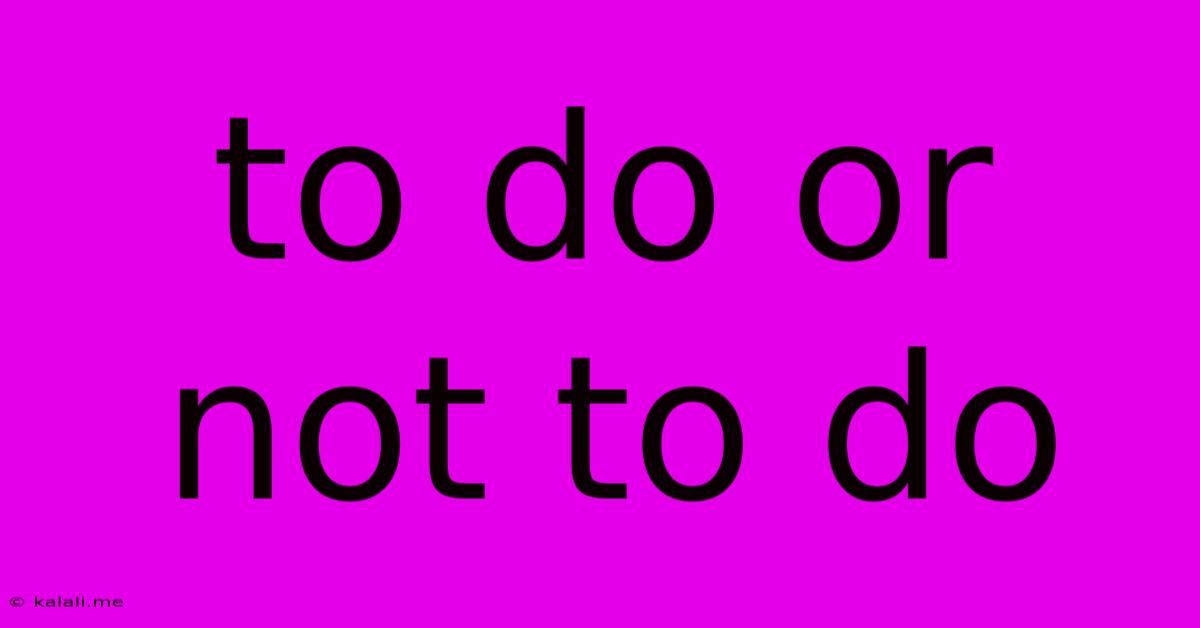To Do Or Not To Do
Kalali
Jun 04, 2025 · 3 min read

Table of Contents
To Do or Not To Do: A Practical Guide to Decision-Making
The age-old question, "To do or not to do," echoes in our minds countless times daily. From minor choices like what to eat for lunch to major decisions impacting our careers and relationships, the struggle of deciding is a universal human experience. This article explores a practical framework to navigate this dilemma, empowering you to make informed choices aligned with your values and goals. This guide will help you weigh pros and cons effectively, understand your priorities, and ultimately, make decisions with confidence.
Understanding the Decision-Making Process
Before diving into the specifics of "to do" or "not to do," it's crucial to understand the underlying decision-making process. This isn't just about weighing pros and cons; it's about understanding your motivations, values, and potential consequences. Many of us fall into the trap of emotional decision-making, driven by fear, excitement, or immediate gratification. A more effective approach involves a structured process:
- Identify the Problem: Clearly define the decision you need to make. What are the specific options available? What are the potential outcomes of each option?
- Gather Information: Research and gather all relevant data. Talk to people who have experience with similar situations. Explore different perspectives.
- Analyze the Options: Create a list of pros and cons for each option. Consider both short-term and long-term implications. Use a decision matrix if it helps visualize the information.
- Evaluate Your Values: Which option aligns best with your core values and long-term goals? This step is crucial for aligning your decisions with your overall life aspirations.
- Make the Decision: Based on your analysis and values, choose the best option. Don't overthink it; you've already done the groundwork.
- Review and Adjust: After implementing your decision, take time to review its effectiveness. Are there adjustments you need to make?
The Art of Weighing Pros and Cons
Creating a balanced list of pros and cons is a cornerstone of effective decision-making. Avoid simply listing items; instead, quantify and qualify them whenever possible. For example, instead of writing "more money," write "potential increase in salary by 15%." Instead of "stressful," write "increased workload leading to potential burnout." This level of detail provides a clearer picture of the potential outcomes.
Consider using a decision matrix to organize your thoughts. This visual tool allows you to rate each option based on different criteria, helping you to identify the most suitable choice based on your priorities.
Beyond the Pros and Cons: Intuition and Gut Feeling
While logical analysis is vital, don't underestimate the power of intuition. After carefully weighing the pros and cons, sometimes your gut feeling provides a crucial piece of the puzzle. This isn't about impulsive decisions; it's about recognizing a subtle feeling that aligns with your deeper understanding of yourself and the situation. Trusting your intuition often leads to more fulfilling choices.
The "Not To Do" List: The Power of Saying No
Learning to say "no" is an essential life skill. Often, the most empowering decision is to not do something. Overcommitting leads to stress, burnout, and ultimately, lower quality work. Saying "no" allows you to prioritize your energy and focus on what truly matters. It frees up time and mental space for activities that align with your goals and bring you joy.
Conclusion: Embracing the Decision-Making Process
The "to do or not to do" dilemma is an ongoing part of life. By implementing a structured decision-making process, thoughtfully weighing pros and cons, and understanding your values, you can approach these decisions with greater confidence and clarity. Remember, the goal isn't to eliminate all uncertainty, but to make informed choices that lead to a more fulfilling and purposeful life. Embrace the process, learn from your decisions, and continue to refine your approach over time.
Latest Posts
Latest Posts
-
Remove Types Of Files You Cans Earch For On Alfred
Jun 06, 2025
-
How Many Amps Does A Washer Use
Jun 06, 2025
-
Reliance 31410crk Transfer Switch Internal Wiring Diagram
Jun 06, 2025
-
A Group Of Scorpions Is Called
Jun 06, 2025
-
R Does The Biggest Cook Distance Point Outlier
Jun 06, 2025
Related Post
Thank you for visiting our website which covers about To Do Or Not To Do . We hope the information provided has been useful to you. Feel free to contact us if you have any questions or need further assistance. See you next time and don't miss to bookmark.